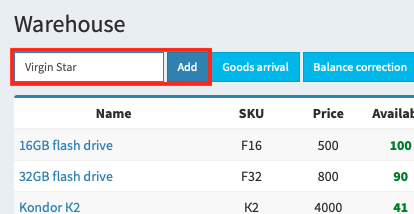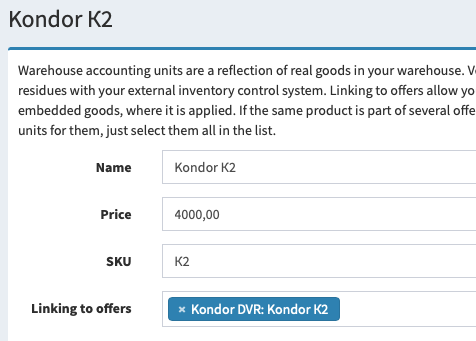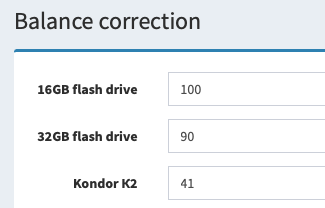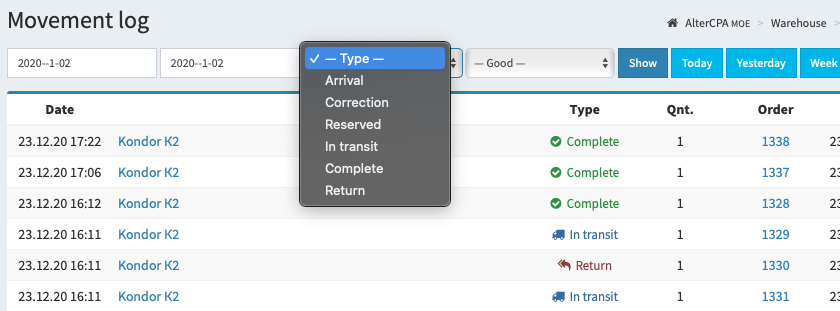Warehouse accounting
AlterCPA Moe allows you to process the warehouse accounting and analyze consumption and sales success in the context of goods. It offers classic operations for the arrival and correction of balances, automatic write-off of goods from confirmed orders and convenient journals for recording movement and statistics. All actions with the warehouse are performed from the "Warehouse" section, which is available only to company administrators, ordinary employees do not see it regardless of the level of access.
Creating goods for accounting
The first step on the way to the nice warehouse accounting will be the preparation of goods. The goods that you start in the warehouse must correspond to the real indivisible objects that are in your boxes.
For example, if you always sell a set of three tubes at once, in a single package and packaged, create the set, not these tubes. If the set is a conditional piece, and the tubes are sometimes sold in pairs or per piece, create each tube in a separate position.

To add a product, you should open warehouse main page and use the form at the top of this page. Enter the name of the product and click "Add". The product setup form will open. Here you can correct the name, specify the SKU, its cost, and set up links with offers.

One and the same warehouse item can be associated with several offer goods. For example, you can sell a cream as the main product in one offer and offer it as an additional purchase in a completely different offer. In this case, just select both nested offer goods in the "Offer Links" field.
Please note that an offer or nested offer good can only be linked to one item in stock. Therefore, when setting up offers, it is undesirable to use positions of the "Set of three identical tubes" type, just create the tube and the quantity of goods.
Arrival and correction of balances
When the list of products is configured, the second important step comes — the product items should be counted and the initial balances entered. To work with the availability of goods, two very similar operations are used — goods arrival and balance correction. They are called by buttons on the main page of the warehouse.
The names of these operations speak for themselves. The arrival of the goods corresponds to the operation, when a vigorous courier of the logistics company arrives at your warehouse and brings a box of "enlarger" creams. You scrupulously count them and indicate in the form of arrival: "Enlarger" — 500 pieces. If some product did not arrive in this delivery, you should leave its field empty. By the way, if a box was taken away from the warehouse, you can also remove this quantity from the warehouse through the arrival, just enter "-500" in the required field.

The balance correction corresponds to the event when an evil boss comes with a belt says in an ominous voice: "It's inventory time!" You calculate the real stock balances and correct them in the corresponding fields of the form. If the product is out of stock, please enter zero.
Important! Items in reserve (order approved, but not yet packed) are considered unavailable. Therefore, it is recommended that the balance correction procedure should be carried out either during the break of the call center, or taking into account the goods in the reserve.
Goods movement log
Any actions that occur with goods in the warehouse are recorded in the movement log, which can be opened by clicking the button from the warehouse main page. These actions can be launched both by the employees responsible for the warehouse when working with balances, and by call center and logistics service operators when working with orders.

The work of warehouse employees with the remainder of the goods generates two operations — "Arrival" and "Correction". They can be both positive and negative, depending on whether the goods arrive at the warehouse or leave the warehouse. If the quantity of goods has not changed during the correction, the operation with zero is not indicated into the journal.
The work of call center operators with an order generates goods consumption transactions. Current balances are displayed to the operator in the form of an order. Expense transactions can be in four states: "Reserved", "In transit", "Complete" and "Return". The status of the reserve corresponds to the orders with the "Packing" and "Shipping" statuses, the state in transit — the "In transit" and "Delivered" statuses. Buyouts and returns — "Complete" and "Return" respectively.
An expense transaction can change its state depending on the order status. When an order moves, for example, from a reserve to transit, a new operation is not generated. Expense transactions always have a positive quantity, but it should be borne in mind that this quantity is withdrawn from the warehouse, and not delivered to it.
Important! If the order is returned, the associated product is not returned to the warehouse, it is simply shown in the returns column. First, in the CPA industry, goods are often cheaper than the return itself, so they are destroyed on the spot. Secondly, it is not always possible to receive the whole product upon return. Therefore, the successfully returned product is added to stock by the operator using the balance correction operation.
Warehouse statistics
Warehouse management AlterCPA Moe provides a simple and useful tool to analyze the success of your products. Statistics opens from the main page of the warehouse by clicking the corresponding button. The report shows statistics on products for the period you selected.

In the columns of the movement, the amount is calculated for the operations of arrival, correction and spend of the corresponding product. Arrival and correction can be both positive and negative, depending on their effect on the quantity of goods. The spend rate is always positive.
The spent columns indicate the number of goods that at the time of the report are in one state or another. In this case, the date of the operation is considered the date of the reservation of the goods. When the status changes, the date of the operation does not change.
The buy-out graphs show three options for the percentage of paid items that can be useful in different use cases:
- The first column indicates the ratio of purchased goods to the total expense, including goods in reserve.
- The second column indicates the ratio of purchased goods to those sent, including goods in transit and returned goods.
- The third column shows the ratio of purchased goods to returned goods, excluding reserves and goods in transit.